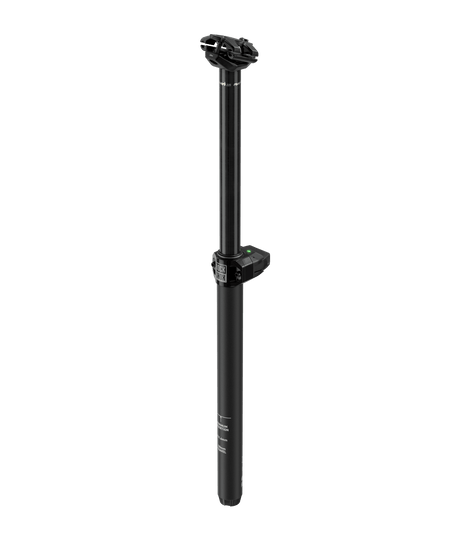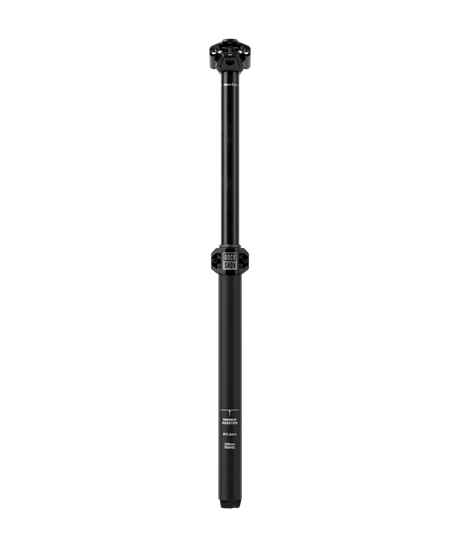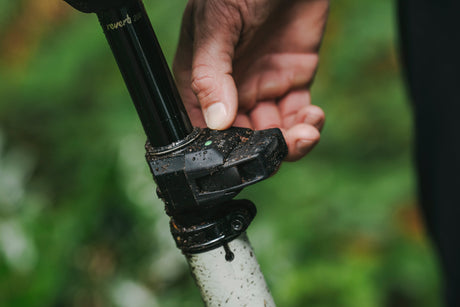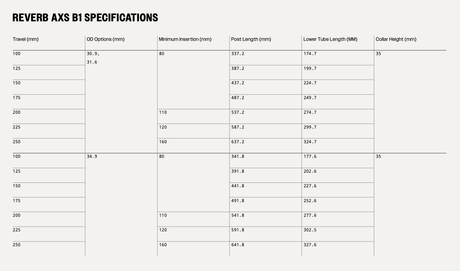Intro
RockShox’s Reverb AXS post launched five years ago, and was one of the first mainstream electronic dropper posts to hit the market. It’s since been the industry standard, but has been looking a bit long in the tooth recently. Today, RockShox is launching the updated Reverb AXS B1, with a complete redesign from the ground up. With up to 250mm of travel, it’s the longest travel dropper post on the market, and actually offers twice as much drop as the original Reverb from 15 years ago. Everything but the battery is completely new for the 2026 RockShox Reverb AXS, and riders can expect a more reliable, easily serviceable, and longer travel wireless experience.
Wireless dropper posts are certainly here to stay, with Fox releasing their Transfer Neo post last summer and now RockShox updating their Reverb AXS. Both posts look like they’re on house arrest with their battery at the collar, a completely different approach than what RockShox used on the previous Reverb AXS. This new collar battery mounting location gives increased wheel clearance compared to the previous design, something everyone will appreciate. On the previous Reverb AXS, some riders were getting custom and spinning their post 180° to avoid clearance issues, but that’s no longer necessary.
RockShox Reverb AXS B1
- Travel: 100, 125, 150, 175, 200, 225, or 250mm
- Diameter: 30.9, 31.6, or 34.9mm
- Actuation: Electronic Wireless AXS System
- Battery: SRAM AXS Battery
- Service Interval: 300 hours of riding or annually
- Weight: 800g (200mm, 31.6mm)
-
MSRP: $549 (remote sold separately)
Details
RockShox has redesigned the internals of the Reverb AXS to feature an Air over Air design, putting all of the rider’s weight on a specially designed air spring with virtually no negative air spring. With virtually no negative air spring at top out, that incredibly high pressure column of air gives the rider a very supportive and firm climbing platform. When the post moves into its travel, then a negative air spring is introduced, which allows the post to compress and bounce a bit in its travel. This is called ActiveRide, which allows riders to drop the post a bit and attack a technical climb with a comfortable and less harsh pedal platform.
RockShox has heard the call for increased serviceability, and they have designed the new Reverb AXS to be entirely serviceable with no special tools. Not only that, there’s also an incredibly broad selection of spares available should anything break. Every year or 300 hours of riding, you’ll need to lubricate the post, and every two years you’ll need to complete a full service. To keep your expensive dropper post going for the long haul, we highly recommend following these service procedures! In case you do ever break anything, you can replace just about any part of this post, including the upper and lower tubes, piston assembly, seat clamp assembly, and even the electronics module at the collar.
Notably absent from the Reverb AXS is any kind of travel adjust shims like we’ve seen on mechanically actuated droppers like the OneUp Dropper Post or the cabled Transfer. Fox’s Transfer Neo can’t be travel adjusted either, and my guess is that an electronic dropper with the actuator on the collar limits the adjustability in that department. All posts that you can travel adjust require you to unscrew the collar and insert little travel spacers from there, and that’s not possible with the current method of mounting the battery to the collar. With 25mm jumps of travel, there’s definitely a post that will work for you, and not a huge need for a travel adjust system.
App and Ecosystem
SRAM’s goal with their AXS app is to simplify the complex, which is exactly what I’m looking for. In their ideal world, riders will have a complete AXS ecosystem, with an AXS derailleur and AXS dropper post, and maybe some AXS Flight Attendant sprinkled in there for good measure. When riders collect all of the pieces of the puzzle, you get to play the game of organizing your control center. With two AXS controllers on your bars, there are tons of options for customizing how you shift, actuate your dropper, and even lock out your suspension. The main purpose of the app is to do exactly that, and customize how your buttons control all of the servos scattered around your bike. There isn’t much of a purpose to the app after everything’s set up, and you won’t need to have your phone with you on your rides to make the post work, but you can always use it to check your exact battery life.
Performance
After getting to ride the RockShox Reverb AXS B1 for about a month, it’s clear to me that RockShox has learned a lot from their previous dropper posts. Having ridden both the previous Reverb AXS and current hydraulic Reverb post, it’s safe to say that the new Reverb AXS B1 is a superior dropper post in every way. While I’m no engineer, and can’t explain exactly how Air over Air works, I can tell you that it’s incredibly effective on trail, performing exactly as SRAM advertised. At full extension, the Reverb AXS has a very solid platform, not sagging at all under my 185 pound weight. When you drop it into its travel to get some extra room for a dynamic move, the post compresses a bit under my weight.
Let’s step back a bit. When I received the post, I didn’t know how much air I should be running in the post or what the maximum air pressure was, but I figured I’d check the stock pressure before installing my seat. Luckily, I used RockShox’s new 600 psi capable shock pump, because it read 525 when I attached it. Had I used any of the other 20 shock pumps around the shop here, I would have been way over their rated maximum pressure, and I was lucky to not learn what happens when you overpressurize a shock pump! I tried to bump the pressure back up to 600, as I always run my dropper posts right at their maximum pressure, but I had a very hard time pumping any air into this post. I could only get it up to about 550 psi before deciding that was probably enough, and it felt more like a body building exercise than dropper post maintenance.
With 550 psi in the post, the return speed is fantastic, similar to other dropper posts with maximum pressure, and it delivers a satisfying top out sound. I don’t have any issues with depressing the post, and my 185 pounds are able to overcome the 550 psi without any issues. Responsiveness from the Pod Controller is just as you’d expect, with effectively instant actuation at the press of either button. Because I’m not integrated in the AXS ecosystem, it’s a bit unnecessary to have two buttons, but that’s the only option I’ve got, so both buttons actuate the dropper post. Maybe one day we could have a button that depresses the post without needing to sit on it, but that day is not today.
Battery life was never an issue, as I’ve always found to be the case with wireless dropper posts. Dropper posts are used far less frequently than a derailleur, especially in the PNW where a typical ride consists of a consistent thousand plus foot climb, followed by a sustained descent, where you may only actuate the post ten to twenty times over the course of a two hour ride. I’ve only had about a month on the post, and while riding about 10 hours a week, I charge the post once a week with no issues with battery life at all. If you’ve got an AXS drivetrain that’s going to drain the battery far before the dropper post, then it’s great to have the ability to swap batteries back and forth to keep your derailleur battery going for longer.
Dropping the post into the travel engages the ActiveRide feature, and it’ll give more or less squish depending on how much you drop the post. The more you drop the post, the more squish there is, and I believe that’s because as you compress the post, the negative air spring becomes larger and larger, pulling the post into its travel more. Typically, I’ll leave my post fully extended while climbing, but when things get incredibly technical, I’ll drop it about 20% into its travel so I can hop around and really maneuver the bike through the jank. I sought out a few of these very tricky sections while testing this post to use the ActiveRide feature, but quickly discovered that while I do lower the post, I don’t really sit on it while making these moves. It provides stability while it’s still high, but I don’t really sit down and use it as a pedal platform. But that’s just me, and I think this feature was designed with ebikers in mind, as I could definitely see myself dropper the saddle while just plowing through chunky terrain if I’m leaning more on the motor to provide the power.
Conclusion
RockShox certainly took their time with updating the Reverb AXS, but it’s clear they’ve been hard at work behind the scenes, with tons of thoughtful updates to make the Reverb AXS B1 our favorite wireless dropper post available today. Especially for riders who find themselves a few standard deviations taller than average, the long travel options are amazing, and this is the first time we’ve seen a 250mm dropper post. With a shorter insertion and lower price than its main competitor, RockShox has created a solid product that we expect lots of riders to enjoy and put to the test on cross country, trail, and enduro bikes.






